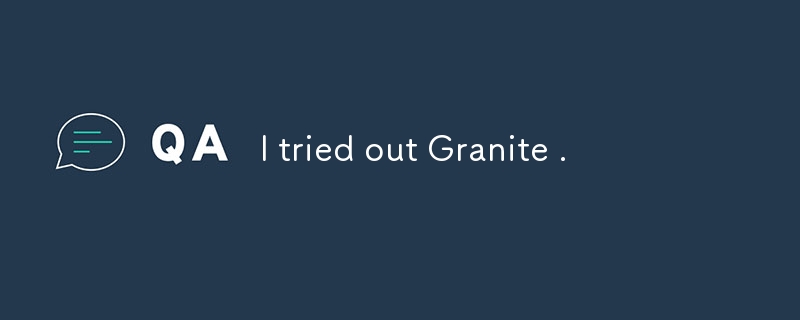
Granite 3.0 是一個開源、輕量級的生成語言模型系列,專為一系列企業級任務而設計。它原生支援多語言功能、編碼、推理和工具使用,適合企業環境。
我測試了運行這個模型,看看它可以處理哪些任務。
我在 Google Colab 中設定了 Granite 3.0 環境,並使用以下指令安裝了必要的函式庫:
!pip install torch torchvision torchaudio !pip install accelerate !pip install -U transformers
我測試了Granite 3.0的2B和8B型號的性能。
我運行了 2B 模型。這是 2B 模型的程式碼範例:
import torch
from transformers import AutoModelForCausalLM, AutoTokenizer
device = "auto"
model_path = "ibm-granite/granite-3.0-2b-instruct"
tokenizer = AutoTokenizer.from_pretrained(model_path)
model = AutoModelForCausalLM.from_pretrained(model_path, device_map=device)
model.eval()
chat = [
{ "role": "user", "content": "Please list one IBM Research laboratory located in the United States. You should only output its name and location." },
]
chat = tokenizer.apply_chat_template(chat, tokenize=False, add_generation_prompt=True)
input_tokens = tokenizer(chat, return_tensors="pt").to("cuda")
output = model.generate(**input_tokens, max_new_tokens=100)
output = tokenizer.batch_decode(output)
print(output[0])
<|start_of_role|>user<|end_of_role|>Please list one IBM Research laboratory located in the United States. You should only output its name and location.<|end_of_text|> <|start_of_role|>assistant<|end_of_role|>1. IBM Research - Austin, Texas<|end_of_text|>
將2b替換為8b即可使用8B模型。以下是 8B 模型的沒有角色和使用者輸入欄位的程式碼範例:
import torch
from transformers import AutoModelForCausalLM, AutoTokenizer
device = "auto"
model_path = "ibm-granite/granite-3.0-8b-instruct"
tokenizer = AutoTokenizer.from_pretrained(model_path)
model = AutoModelForCausalLM.from_pretrained(model_path, device_map=device)
model.eval()
chat = [
{ "content": "Please list one IBM Research laboratory located in the United States. You should only output its name and location." },
]
chat = tokenizer.apply_chat_template(chat, tokenize=False, add_generation_prompt=True)
input_tokens = tokenizer(chat, add_special_tokens=False, return_tensors="pt").to("cuda")
output = model.generate(**input_tokens, max_new_tokens=100)
generated_text = tokenizer.decode(output[0][input_tokens["input_ids"].shape[1]:], skip_special_tokens=True)
print(generated_text)
1. IBM Almaden Research Center - San Jose, California
我探索了函數呼叫功能,並使用虛擬函數對其進行了測試。這裡,get_current_weather 被定義為傳回模擬天氣資料。
import json
def get_current_weather(location: str) -> dict:
"""
Retrieves current weather information for the specified location (default: San Francisco).
Args:
location (str): Name of the city to retrieve weather data for.
Returns:
dict: Dictionary containing weather information (temperature, description, humidity).
"""
print(f"Getting current weather for {location}")
try:
weather_description = "sample"
temperature = "20.0"
humidity = "80.0"
return {
"description": weather_description,
"temperature": temperature,
"humidity": humidity
}
except Exception as e:
print(f"Error fetching weather data: {e}")
return {"weather": "NA"}
我建立了一個呼叫函數的提示:
functions = [
{
"name": "get_current_weather",
"description": "Get the current weather",
"parameters": {
"type": "object",
"properties": {
"location": {
"type": "string",
"description": "The city and country code, e.g. San Francisco, US",
}
},
"required": ["location"],
},
},
]
query = "What's the weather like in Boston?"
payload = {
"functions_str": [json.dumps(x) for x in functions]
}
chat = [
{"role":"system","content": f"You are a helpful assistant with access to the following function calls. Your task is to produce a sequence of function calls necessary to generate response to the user utterance. Use the following function calls as required.{payload}"},
{"role": "user", "content": query }
]
使用以下程式碼,我產生了一個回應:
instruction_1 = tokenizer.apply_chat_template(chat, tokenize=False, add_generation_prompt=True)
input_tokens = tokenizer(instruction_1, return_tensors="pt").to("cuda")
output = model.generate(**input_tokens, max_new_tokens=1024)
generated_text = tokenizer.decode(output[0][input_tokens["input_ids"].shape[1]:], skip_special_tokens=True)
print(generated_text)
{'name': 'get_current_weather', 'arguments': {'location': 'Boston'}}
這證實了模型能夠根據指定城市產生正確的函數呼叫。
Granite 3.0 允許格式規格以促進結構化格式的回應。本節說明如何使用 [UTTERANCE] 進行回應,並使用 [THINK] 進行內心想法。
另一方面,由於函數呼叫以純文字形式輸出,因此可能需要實作單獨的機制來區分函數呼叫和常規文字回應。
以下是指導 AI 輸出的範例提示:
prompt = """You are a conversational AI assistant that deepens interactions by alternating between responses and inner thoughts. <Constraints> * Record spoken responses after the [UTTERANCE] tag and inner thoughts after the [THINK] tag. * Use [UTTERANCE] as a start marker to begin outputting an utterance. * After [THINK], describe your internal reasoning or strategy for the next response. This may include insights on the user's reaction, adjustments to improve interaction, or further goals to deepen the conversation. * Important: **Use [UTTERANCE] and [THINK] as a start signal without needing a closing tag.** </Constraints> Follow these instructions, alternating between [UTTERANCE] and [THINK] formats for responses. <output example> example1: [UTTERANCE]Hello! How can I assist you today?[THINK]I’ll start with a neutral tone to understand their needs. Preparing to offer specific suggestions based on their response.[UTTERANCE]Thank you! In that case, I have a few methods I can suggest![THINK]Since I now know what they’re looking for, I'll move on to specific suggestions, maintaining a friendly and approachable tone. ... </output example> Please respond to the following user_input. <user_input> Hello! What can you do? </user_input> """
產生回應的程式碼:
chat = [
{ "role": "user", "content": prompt },
]
chat = tokenizer.apply_chat_template(chat, tokenize=False, add_generation_prompt=True)
input_tokens = tokenizer(chat, return_tensors="pt").to("cuda")
output = model.generate(**input_tokens, max_new_tokens=1024)
generated_text = tokenizer.decode(output[0][input_tokens["input_ids"].shape[1]:], skip_special_tokens=True)
print(generated_text)
輸出如下:
[UTTERANCE]Hello! I'm here to provide information, answer questions, and assist with various tasks. I can help with a wide range of topics, from general knowledge to specific queries. How can I assist you today? [THINK]I've introduced my capabilities and offered assistance, setting the stage for the user to share their needs or ask questions.
[UTTERANCE] 和 [THINK] 標籤已成功使用,允許有效的回應格式。
根據提示的不同,輸出中有時可能會出現結束標籤(例如[/UTTERANCE]或[/THINK]),但總的來說,一般都可以成功指定輸出格式。
讓我們看看如何輸出流響應。
以下程式碼使用 asyncio 和線程庫來非同步傳輸來自 Granite 3.0 的回應。
!pip install torch torchvision torchaudio !pip install accelerate !pip install -U transformers
執行上述程式碼將產生以下格式的非同步回應:
import torch
from transformers import AutoModelForCausalLM, AutoTokenizer
device = "auto"
model_path = "ibm-granite/granite-3.0-2b-instruct"
tokenizer = AutoTokenizer.from_pretrained(model_path)
model = AutoModelForCausalLM.from_pretrained(model_path, device_map=device)
model.eval()
chat = [
{ "role": "user", "content": "Please list one IBM Research laboratory located in the United States. You should only output its name and location." },
]
chat = tokenizer.apply_chat_template(chat, tokenize=False, add_generation_prompt=True)
input_tokens = tokenizer(chat, return_tensors="pt").to("cuda")
output = model.generate(**input_tokens, max_new_tokens=100)
output = tokenizer.batch_decode(output)
print(output[0])
此範例示範了成功的串流。每個token都是非同步生成並順序顯示,讓使用者可以即時查看生成過程。
Granite 3.0 即使使用 8B 機型也能提供相當強的反應。函數呼叫和格式規範功能也運作良好,顯示其具有廣泛的應用潛力。
以上是我嘗試過花崗岩。的詳細內容。更多資訊請關注PHP中文網其他相關文章!




